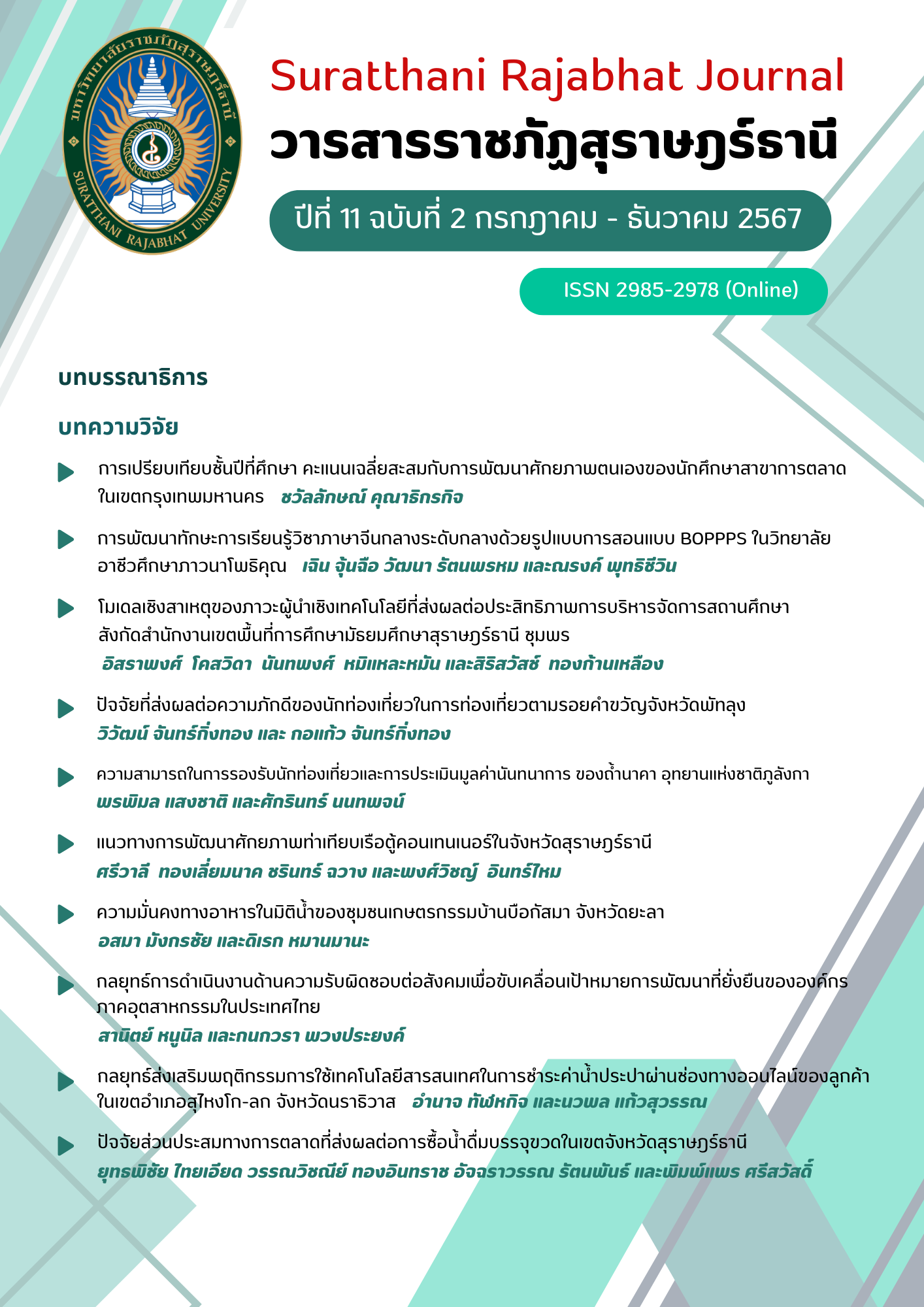ปัจจัยที่ส่งผลต่อความภักดีของนักท่องเที่ยวในการท่องเที่ยวตามรอยคำขวัญจังหวัดพัทลุง
Main Article Content
บทคัดย่อ
การวิจัยนี้มีวัตถุประสงค์เพื่อตรวจสอบปัจจัยที่ส่งผลต่อความภักดีของนักท่องเที่ยวในการท่องเที่ยวตามรอยคำขวัญจังหวัดพัทลุง กลุ่มตัวอย่าง คือ นักท่องเที่ยวชาวไทยที่เข้ามาท่องเที่ยวตามคำขวัญจังหวัดพัทลุง จำนวน 420 คน เลือกมาโดยการสุ่มตัวอย่างแบบโควตาและแบบบังเอิญ เครื่องมือที่ใช้ในการเก็บข้อมูล คือ แบบสอบถามที่มีค่าความเชื่อมั่นอยู่ระหว่าง 0.90-0.94 ทำการเก็บข้อมูลกับนักท่องเที่ยวที่ท่องเที่ยวเสร็จแล้ว และทำการวิเคราะห์ข้อมูลด้วยโปรแกรม LISREL 8.80 โดยโมเดลที่ศึกษาประกอบด้วยตัวแปรแฝงซึ่งเป็นสาเหตุของความภักดีของนักท่องเที่ยว จำนวน 3 ตัวแปร ได้แก่ ภาพลักษณ์การท่องเที่ยว คุณค่าที่ได้รับจากการท่องเที่ยว และความพึงพอใจของนักท่องเที่ยว ผลการวิจัย พบว่า ปัจจัยที่ส่งผลทางตรงต่อความภักดีของนักท่องเที่ยว ประกอบด้วย ภาพลักษณ์การท่องเที่ยว คุณค่าที่ได้รับจากการท่องเที่ยว และความพึงพอใจของนักท่องเที่ยว สัมประสิทธิ์อิทธิพลเท่ากับ 0.23, 0.42 และ 0.29 ตามลำดับ ในขณะที่ปัจจัยที่ส่งผลทางอ้อมต่อความภักดีของนักท่องเที่ยว ประกอบด้วย ภาพลักษณ์การท่องเที่ยว และคุณค่าที่ได้รับจากการท่องเที่ยว สัมประสิทธิ์อิทธิพลเท่ากับ 0.26 และ 0.21 ตามลำดับ ในส่วนขององค์ความรู้ที่ค้นพบของวิจัยนี้ คือ คุณค่าที่ได้รับจาก การท่องเที่ยวเป็นปัจจัยที่ส่งผลต่อความภักดีของนักท่องเที่ยวมากที่สุด โดยความภักดีของนักท่องเที่ยวเกิดขึ้นจากการได้รับคุณค่าจากการท่องเที่ยว และรู้สึกคุ้มค่าในการเข้ามาท่องเที่ยว โดยมีข้อเสนอแนะให้หน่วยงานและผู้ประกอบการที่เกี่ยวข้องควรร่วมมือกันสร้างภาพลักษณ์และส่งเสริมคุณค่าของการท่องเที่ยว เพื่อให้นักท่องเที่ยวเกิดความพึงพอใจ อันนำไปสู่ความภักดีของนักท่องเที่ยว
Article Details

อนุญาตภายใต้เงื่อนไข Creative Commons Attribution-NonCommercial-NoDerivatives 4.0 International License.
เอกสารอ้างอิง
Ajzen, I. (1991). The Theory of Planned Behavior. Organizational Behavior and Human Decision Processes, 50(2), 179-211. https://doi.org/10.1016/0749-5978(91)90020-T.
Bhat, S.A. & Darzi, MA. (2018). Antecedents of Tourist Loyalty to Tourist Destinations: A Mediated-Moderation Study. International Journal of Tourism Cities, 4(2), 261-278. https://doi.org/10.1108/IJTC-12-2017-0079.
Cristobal-Fransi, E., Daries, N., Ferrer-Rosell, B., Marine-Roig, E. & Martin-Fuentes, E. (2020). Sustainable Tourism Marketing. Sustainability, 12(5), 1-4. https://doi.org/10.3390/su12051865.
Governor’ s Office of Phatthalung Province. (2020). The Slogan of Phatthalung Province. (in Thai). http://www.phatthalung.go.th/manager_gallery/detail/1448.
Hair, J. F., Black, W. C., Babin, B. J. & Anderson, R. E. (2014). Multivariate Data Analysis (7th ed.), Upper Saddle River, 646-647.
Haji, S., Surachman, S., Ratnawati, K. & MintartiRahayu, M. (2021). The effect
of experience quality, perceived value, happiness and tourist satisfaction on behavioral intention. Management Science Letters, 11(3), 1023-1032. https://doi.org/10.5267/j.msl.2020.9.040.
Kline, R.B. (2015). Principles and Practice of Structural Equation Modeling, Guilford Publications, 223-226.
LE, H.B.H. & LE, T.B. (2020). Impact of Destination Image and Satisfaction on Tourist Loyalty: Mountain Destinations in Thanh Hoa Province, Vietnam. The Journal of Asian Finance, Economics and Business, 7(4), 185-195.
https://doi.org/10.13106/jafeb.2020.vol7.no4.185
Libre, A., Manalo, A. & Laksito, G.S. (2022). Factors Influencing Philippines Tourist’ Revisit Intention: The Role and Effect of Destination Image, Tourist Experience, Perceived Value, and Tourist Satisfaction. International Journal of Quantitative Research and Modeling, 3(1), 1-12. https://doi.org/10.46336/ijqrm.v3i1.260.
Martini, U. & Buffa, F. (2020). Marketing for Sustainable Tourism. Sustainability, 12(5), 1-6. https://doi.org/10.3390/books978-3-03928-874-8.
Perri, 6. & Bellamy, C. (2012). Principles of Methodology: Research Design in Social Science, SAGE, 104-105.
Ramseook-Munhurrun, P., Seebaluck, V.N. & Naidoo, P. (2015). Examining the Structural Relationships of Destination Image, Perceived Value, Tourist Satisfaction and Loyalty: Case of Mauritius. Procedia-Social and Behavioral Sciences, 175, 252-259. https://doi.org/10.1016/j.sbspro.2015.01.1198
Rather, R.A. & Jaziri, D. (2022). Unveiling the Customer Experience–Loyalty Nexus in Tourism During Crises. In Contemporary Approaches Studying Customer Experience in Tourism Research (267-280). Emerald.
Rodríguez-Díaz, M. & Espino-Rodríguez, T.F. (2019). Tourism Destination Management, MDP/I, 71-72.
Rohman, F. (2020). Determining Adventure Tourist Loyalty: Mediating Role of Tourist Satisfaction and Quality of Life. The Journal of Asian Finance, Economics and Business, 7(10), 255-265. https://doi.org/10.13106/jafeb.2020.vol7.n10.255
Ruangkalapawongse, A. & Ruangkalapawongse, S. (2020). Structural equation model of tourist loyalty toward Dvaravati civilization tourist attraction to be served as a center of western creative tourism. University of the Thai Chamber of Commerce Journal Humanities and Social Sciences, 40(1), 18-40. https://so06.tci-thaijo.org/index.php/utccjournalhs/article/view/215507
Schumacher, R.E. & Lomax, R.G. (2010). A Beginner's Guide to Structural Equation Modeling (3rd ed.), Routledge, 85-91.
Wutti, M. & Jankingthong, W. (2020). Factors affecting customer loyalty of Centara Hotel Hat Yai. Hatyai Academic Journal, 19(1), 113-129. https://so01.tci-thaijo.org/index.php/HatyaiAcademicJournal/article/view/222840/167754


